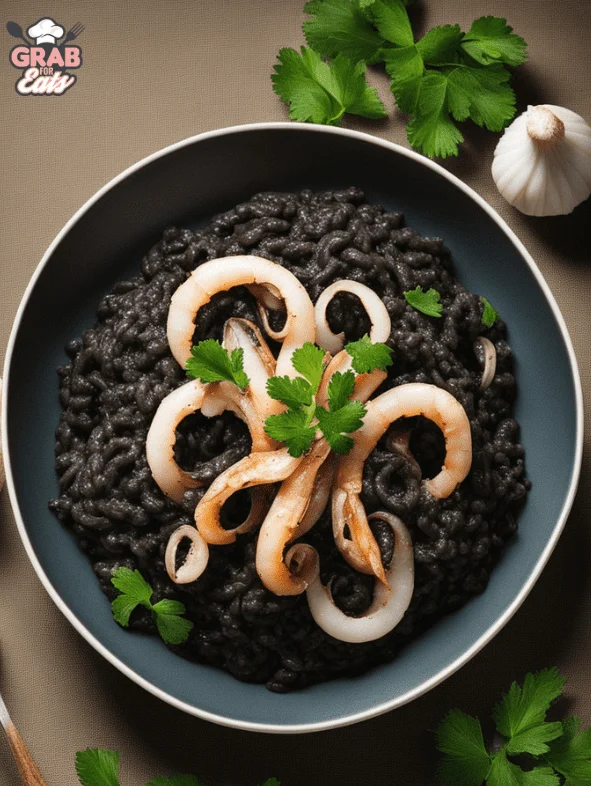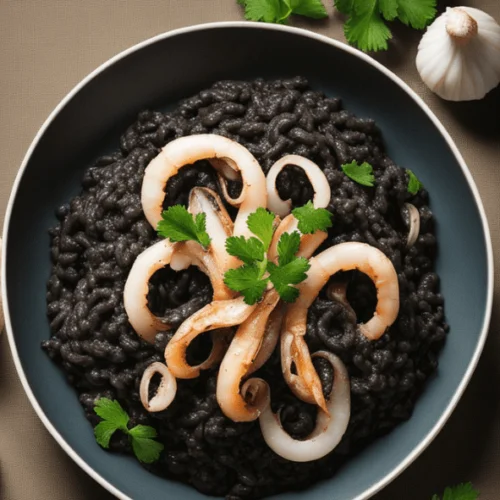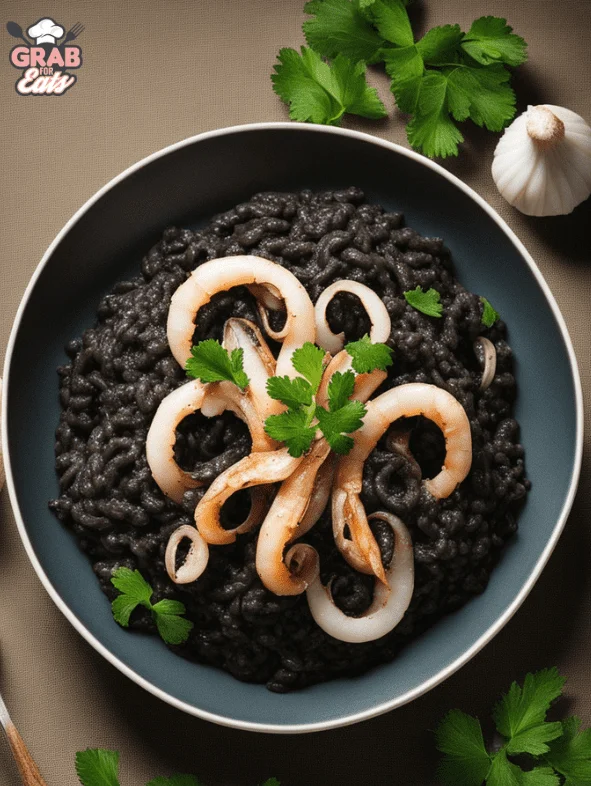Risotto Nero is a classic Venetian rice dish that combines rice, seafood, and cuttlefish or squid ink to create a rich, creamy, and black-colored risotto.
The liquid that colors and flavors Risotto Nero is in fact the same liquid that an artist uses in a sepia drawing, but the cooked dish usually looks more green – a deep, sea green – than black. Some versions look gray, the variations in color depending on the amount of ink, white wine and fish stock in proportion to the amount of rice. This is a venetian classic that takes time to cook, but is absolutely worth it!

History
Risotto is a creamy rice dish that originated in northern Italy, specifically in the region of Lombardy.1 It is made by cooking short- or medium-grain rice with broth, butter, onion, wine, and cheese, and stirring it frequently to release the starch.
Risotto dates back to the 16th century, when rice was introduced to Italy by Arab traders. The first recorded recipe for risotto was called “riso alla Milanese” and included saffron, which gave the rice a yellow color and a distinct flavor.2
Risotto became a popular dish in Italy and abroad, and many variations were developed over time. Some of the most famous types of risotto are risotto nero (with squid ink), risotto al Barolo (with red wine), risotto ai funghi (with mushrooms), and risotto alla pescatora (with seafood).
What is Risotto?
Risotto and long-grain rice are two different types of rice that are used for different dishes. Risotto requires short-grain rice with a high starch content, which helps create a firm but creamy texture when cooking. Long-grain rice is more frequently used for other dishes like fried rice, Spanish rice, or pilaf.
How to Make Risotto Nero
What type of Rice
Risotto is traditionally made with Arborio rice. Arborio rice is a starchy, short-grain rice that releases it’s starch when cooked, giving it a firmer and creamier texture than other rice. Some other great types of rice for risotto nero are Carnaroli and Vialone Nano, which have large and tapered grains that absorb the flavors and remain al dente.
Where to Buy Squid Ink or Cuttlefish Ink
Squid ink is a unique ingredient that is common in dishes from coastal locales around the world. Squid ink adds a briny flavor to the dish, as well as giving the risotto a unique color. Shop for squid or cuttlefish ink at your local gourmet grocery or seafood store.
Key Steps When Cooking Risotto Nero
Any risotto dish requires the following foundational steps to give the necessary depth of flavor and texture to the dish:
- Sautéing: Typically cooking risotto begins with sautéing onions and garlic to give the risotto a flavorful base.
- Toasting the Rice: Arborio rice is then added to the sautéed onions and lightly toasted. This step helps the rice absorb liquids more effectively, contributing to the creamy texture.
- Deglazing with Wine: White wine is often added to the rice, deglazing the pan and adding a layer of acidity to balance the dish.
- Gradual Addition of Broth: Hot broth, is added to the rice one ladle at a time. The liquid is absorbed gradually, and the constant stirring helps release the starches from the rice, creating a creamy texture. Be patient and let each ladle of broth be absorbed before adding another.
- Seasoning and Additional Ingredients: Risotto is seasoned with salt and pepper, and additional ingredients such as herbs, vegetables, meats, or seafood can be added for flavor and variety.
- Final Touch: The cooking process continues until the rice is al dente (firm to the bite) and has a creamy consistency. The final touch often involves stirring in Parmesan cheese and sometimes butter to enhance the richness.
How Much Risotto Do You Need Per Serving?
We recommend that you use ½ cup uncooked rice per person if you aren’t serving any sides, or ⅓ cup if you have other dishes. This means that with 2 cups of rice you can serve 4-6 dishes of risotto.
What to serve with Risotto Nero?
Risotto Nero has a rich and savory flavor due to the squid ink. Here are some food that pair well with this dish:
- Fresh Garden Salad: A crisp green salad with a light vinaigrette can serve as a refreshing side dish to balance the richness of the risotto. Arugula or mixed greens with a lemony dressing are good choices. Try our version of Giordano’s Lemon Vinaigrette with this salad.
- Bruschetta: Toasted or grilled bread with fresh tomato, garlic, and basil bruschetta can add a textural and flavorful contrast to the creamy risotto.
- Grilled Chicken: A simple grilled or roasted chicken, seasoned with herbs like rosemary or thyme, can complement the seafood flavors in the risotto.

Ingredients
- 6 cups of seafood stock or vegetable stock
- 3 tbsp of extra virgin olive oil
- 1 medium onion finely chopped
- 1 small clove of garlic minced
- Pinch of chili flakes
- 2 cups of Arborio rice
- 1/2 cup of dry white wine optional
- 2 tbsp of squid ink if your squid doesn’t come with ink sacs
- 2 tbsp of butter optional
- 10 oz of squid or cuttlefish cleaned and cut into bite-sized pieces
- Lemon juice to taste
- Salt and black pepper to taste
- Parsley chopped, for garnish
Instructions
Prepare the Squid or Cuttlefish:
- Clean the squid or cuttlefish, removing the heads, beaks, and internal organs.
- Rinse well and pat dry with paper towels.
- Finely chop the squid or cuttlefish into small pieces.
Sauté Onion and Garlic:
- In a large, deep skillet or a wide saucepan, heat olive oil over medium heat.
- Add chopped onion, chili flakes and minced garlic. Sauté until softened.
Cook the Squid or Cuttlefish:
- Add the chopped squid or cuttlefish to the skillet.
- Cook for about 5-7 minutes until the seafood is opaque and cooked through.
Add Arborio Rice:
- Stir in Arborio rice and cook for 2-3 minutes until the rice is lightly toasted.
Deglaze with White Wine:
- Pour in the white wine, stirring constantly until the liquid is mostly absorbed.
Begin Adding Broth:
- Ladle in a cup of warm broth to the rice mixture.
- Stir continuously until the liquid is mostly absorbed.
Incorporate Squid Ink:
- Dissolve the squid ink in a couple of tablespoons of warm broth.
- Add the dissolved ink to the risotto, stirring well to evenly distribute the color.
Continue Adding Broth:
- Continue adding the warm broth, one ladle at a time, stirring frequently.
- Allow each addition of broth to be absorbed before adding more.
Season and Finish:
- Season with salt and black pepper to taste.
- Continue cooking until the rice is creamy and al dente.
- Stir in butter to add richness and
Serve:
- Garnish with chopped fresh parsley and squeeze a bit of lemon juice to brighten to dish
Nutrition
And that’s how to make risotto nero with squid ink! I hope that you enjoy this delicious risotto nero recipe. Mangiare bene!





Great! Unique experience for us.